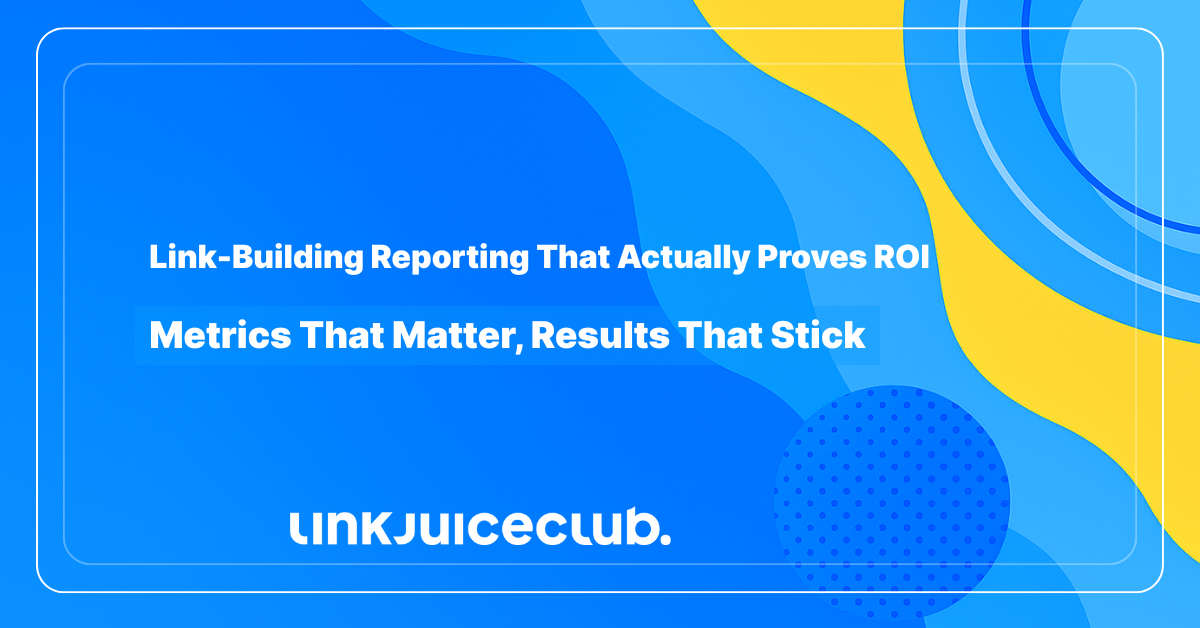
Link-Building Reporting That Actually Proves ROI: Metrics That Matter, Results That Stick
Most people think link building ends when the backlink goes live. Not even close. Link-building reporting is where the real magic happens — it’s how you turn behind-the-scenes SEO into boardroom results.
Top-ranking pages on Google have almost 4x more backlinks than their competitors. But it’s not just a numbers game. Smart SEOs know: the link itself is just step one. Measuring the ripple effect? That’s what drives strategy.
Here’s where most campaigns fall flat…
They count links like coins, but ignore the currency of:
- Domain authority and link quality
- Anchor text relevance
- Traffic flow from referral sites
- Keyword movement tied to each link drop
🧠 And unless you can translate all that into ROI — in plain English — stakeholders won’t buy in.
Let’s dive into the data points that make link-building reporting less about guesswork, and more about results you can see, measure, and scale.
Why Link-Building Reporting Isn’t Optional — It’s Your SEO GPS
Links don’t work on blind faith.
You can hustle for weeks, stacking backlinks like trophies… and still miss the mark if you’re not tracking the right signals. In fact, nearly 40% of SEOs say it takes six weeks or more to see any traffic lift — and that’s only if you’re watching the right indicators.
📍 Link-building reporting isn’t just a technical add-on — it’s your roadmap to what’s working, what’s not, and where to double down.
Here’s why skipping it is like flying blind:
🧭 You Can’t Scale What You Can’t See
- Without reporting, you’re guessing — and that’s expensive.
- Are those high-DA placements pulling weight? Or are they just vanity metrics?
- Which links actually led to ranking gains or referral traffic?
💡 Insight = strategy. And strategy = ROI.
💬 It Translates SEO Into Business Language
- Link building is a long game — and stakeholders hate waiting.
- Reporting bridges the gap, showing movement through:
- Domain authority changes
- Organic visibility lifts
- Keyword ranking progress
- Referral traffic trends
- Domain authority changes
✅ The right numbers calm the “why are we spending this much?” questions before they start.
🔍 It Catches What Tools Alone Miss
- Not every backlink is a win. Some:
- Never get indexed
- Vanish within weeks
- Come from shady neighborhoods
- Never get indexed
📉 Regular reporting surfaces toxic or broken links before they drag you down.
Essential Link‑Building Reporting Metrics That Drive Real SEO Wins
Winning at link‑building isn’t about collecting every backlink—it’s about tracking the ones that actually shift the needle.
Here are the top 10 metrics to monitor, explained in an actionable way that’s easy to replicate:
1. Domain Authority (DA) / Domain Rating (DR)
Not all backlinks carry weight — some barely tip the scale. That’s where DA and DR come in. These scores (from Moz and Ahrefs) help you measure the strength of a linking domain. The higher the score, the more trust and potential SEO power it can pass your way.
But here’s the nuance: high DR doesn’t always mean high value. A backlink from a DR 80 tech blog is gold for your SaaS platform — but meaningless if you’re in wellness or ecommerce. Relevance is the real multiplier.
Keep an eye on how your own DA/DR changes over time. Steady growth here often reflects a healthy, diverse link profile. Plot your improvements month over month — visuals beat raw numbers every time when showing stakeholders progress. 📈
Don’t fixate on DR like it’s gospel. Use it to guide your strategy, not define it.
2. Referring Domains
It’s not about how many backlinks you stack — it’s about who’s vouching for you. That’s the magic of referring domains: each one is a unique vote of confidence.
Getting 20 links from one blog? That’s 20 backlinks, but only one referring domain. Google’s more impressed by 10 links from 10 different sites — that shows you’re gaining traction across the web.
💡 Want to build momentum? Aim for a consistent drip of new referring domains, even just 5–10 per month. This signals to Google that you’re organically gaining popularity.
Keep your growth graph smooth — not spiky. A sudden flood of new domains can trigger red flags. If your profile looks bought, it might get treated that way.
And don’t forget to track which domains you’re losing, too. If strong referrers drop off, investigate why and consider re-engaging or replacing the gap.
3. New Backlinks (Volume + Velocity)
New backlinks show your campaign is moving — but movement without direction is just noise. The volume of links you’re earning matters, but only when paired with velocity — how fast and consistently they’re coming in.
You’re looking for that Goldilocks pace: not so slow that progress stalls, not so fast that it screams spammy. A gentle, consistent rise keeps things natural in Google’s eyes. 📊
Track your new links monthly, noting:
- Number of dofollow vs. nofollow
- Referring domain spread
- Placement type (contextual, directory, author bio, etc.)
Watch for dry spells or sudden spikes. The former signals stagnation, the latter could point to risky tactics or unnatural link placement.
When reviewing backlink velocity, link it to campaign efforts: “This surge followed our guest posting sprint” or “Our digital PR push delivered 8 links from high-authority publishers in 3 weeks.” Context turns numbers into narratives.
4. Anchor Text Diversity
Anchor text isn’t just the clickable blue text — it’s a powerful signal to Google about your content. Use the same anchor over and over (like “best CRM”), and Google might start thinking you’re gaming the system. Use a rich, varied mix, and it sees you as a natural part of the web.
Healthy anchor text profiles blend:
- Brand mentions
- Naked URLs (like https://yoursite.com)
- Generic terms (“click here”)
- Long-tail phrases
- Occasional partial or exact matches
🔍 Start tracking which anchors dominate your profile. Too many of the same keyword? Time to mix it up in your outreach templates or guest post content.
A diverse anchor spread keeps your link profile natural — which means safer, more sustainable SEO wins. It also opens up semantic signals that can help you rank for broader variations of your keywords.
Keep the mix intentional. Don’t just chase exact-match anchors — own your brand, tell your story, and Google will follow.
5. Page Authority (PA) / URL Rating (UR)
DA/DR tells you how powerful a domain is — PA/UR tells you how strong a page is. And in the world of backlinks, it’s the page that passes the juice.
You could score a link on a DR 80 site… but if it’s buried on a low-traffic, low-UR page with no backlinks of its own? The impact might be barely a ripple.
Here’s the smarter play: prioritize links from high-UR pages that are indexed, linked to, and ideally, already ranking for something. These pages have their own authority — which they can share with you.
🎯 Pro move: Check if the page that linked to you has backlinks itself. If it does, that link’s value just went up. If it doesn’t, it’s a static node — not passing much on.
And don’t ignore context. A link inside a relevant, content-rich page outperforms a random footer or sidebar any day.
6. Dofollow vs. Nofollow Ratio
Every backlink falls into one of two camps: dofollow (passes SEO power) or nofollow (doesn’t — at least not directly). But don’t make the rookie mistake of thinking only dofollow matters.
A smart, balanced link profile contains both. Google expects it. If every link you earn is dofollow, you might start looking like a link buyer. 🚨
Think of it this way:
- Dofollow = raw SEO value
- Nofollow = branding, traffic, trust signals
A nofollow link from Reddit, a popular industry forum, or a niche newsletter still brings traffic and relevance. It also paints a more realistic picture of your online footprint.
📉 Track your ratio monthly. Too heavy on nofollows? Time to build intentional dofollow placements. All dofollow? Time to layer in variety.
Google sees patterns — and a natural one always beats an engineered one.
7. Referral Traffic from Backlinks
Let’s get real — not every backlink has to serve an SEO purpose. Some links are traffic highways. They send people straight to your site, skipping the search engine middleman entirely.
And that traffic? It’s gold. It’s relevant, high-intent, and often more engaged. That’s why referral traffic is a crucial piece of your link-building report.
👀 You’ll want to monitor:
- Sessions by referral source (in GA4)
- Time on page and bounce rate for those users
- Conversion behavior (downloads, signups, purchases)
Not every link will drive traffic — but when you find those that do, spotlight them. They’re worth their weight in lead-gen strategy alone.
Pro tip: Layer UTM tags on major content placements so you can track traffic attribution cleanly. When that blog post on a DR 60 site drives 500 visits and 20 signups? That’s ROI you can prove.
8. Competitor Backlink Analysis & Link Indexing
This is where your link-building strategy shifts from reactive to proactive. Your competitors are getting links right now — the only question is, from where?
Run regular audits on competitor domains. Spot patterns: are they guest posting on niche blogs you’ve never pitched?
Are industry directories listing them but not you? Those are your backlink gaps — and your next moves.
At the same time, don’t neglect your own indexing. A link only matters if Google knows it exists. Backlinks that aren’t indexed won’t pass value, no matter how shiny the DR.
🔗 Check:
- Your top recent backlinks — are they indexed?
- Have competitors picked up new domains you’re missing?
- Are any high-value links dropping out of Google’s radar?
This dual analysis keeps you one step ahead — and ensures no link equity is slipping through the cracks.
9. Quality of Sponsored / Purchased Links
If you’re paying for placements, every dollar needs to pull double-duty. You’re not just buying a link — you’re investing in authority, relevance, and reputation.
That means due diligence is non-negotiable:
- Is the site relevant to your niche?
- Is the content evergreen, well-written, and indexed?
- Is your link embedded contextually, not slapped into a “sponsored post” graveyard?
💸 Just because it’s paid doesn’t make it powerful. In fact, some paid placements are more risk than reward — especially if the domain is on too many “link seller” lists.
Track these links like assets. Monitor their referral traffic, their PA/UR, and whether they stay indexed over time. Any drop? Flag it fast.
And always document your process. This transparency can protect you during SEO audits and proves to stakeholders that your strategy isn’t “spray and pray” — it’s intentional, cautious, and ROI-focused.
10. Toxic or Removed Backlinks
Some links are a blessing. Others? A ticking time bomb.
Spammy domains, links from hacked pages, or shady PBNs can sneak into your backlink profile — especially if you’re building fast or using freelance vendors. If Google senses you’re mingling with manipulative link schemes, you’ll feel it in the rankings.
Toxic links can also come from link drops — pages that no longer exist, have been deindexed, or quietly removed your backlink.
🧼 The fix? Regular link hygiene. Use tools like Moz, SEMrush, or Ahrefs to scan your profile for:
- Links from domains with a spam score >30%
- Anchors filled with gibberish or keyword stuffing
- Links that disappear from Google’s index
Disavow the worst offenders. Flag the borderline ones. Then rebuild with better.
Healthy SEO isn’t just about earning links — it’s about pruning the bad ones, too.
Why Link-Building Reporting Isn’t Just for the Pros — It’s Your Growth Decoder
Let’s clear something up: link-building reporting isn’t just for SEO nerds with 10-monitor setups and a spreadsheet addiction. It’s for anyone serious about turning effort into outcomes.
Because when you track the right signals, you stop chasing links like you’re throwing darts in the dark — and start building with intent.
Here’s what changes when you do it right:
- You go from “let’s build more links” to “let’s build the ones that move rankings.”
- You translate SEO into numbers the CMO actually cares about: links → traffic → leads → 💰.
- You start spotting patterns — like how links from industry blogs push product pages to page one, or how certain anchors consistently lift rankings.
In short? Link-building reporting turns chaos into clarity.
It connects the dots between strategy and results, links and revenue, outreach and outcomes. And even if you’re new to the SEO game, this is the one practice that instantly levels you up from link hustler to performance marketer.
Because SEO without reporting is guesswork — and guesswork doesn’t scale.

Why Smart Brands Outsource Link-Building Reporting (And Never Look Back)
Let’s be real — backlink reporting isn’t just tedious. It’s a maze of spreadsheets, tools, charts, and second-guessing. One broken formula or missed metric, and suddenly you’re explaining to your client why rankings dropped when you think they shouldn’t have.
That’s where a specialized link-building service like Link Juice Club flips the script. You’re not just buying backlinks — you’re buying clarity, confidence, and consistency.
Here’s what you actually get when the pros take the wheel:
✨ Precision without the pressure
Link Juice Club doesn’t leave results up to fate. Every link is tracked — DR, anchor text, traffic movement, keyword lifts — all broken down in reports that make sense to humans, not just SEO geeks.
🎯 Reporting that aligns with your business goals
Whether you’re laser-focused on traffic, building topical authority, or proving ROI to your CEO, your reports get built around your KPIs. No filler. No fluff.
🔎 Visibility into what’s working (and what’s not)
You don’t just see the links. You see what they’re doing. Which ones are driving clicks, rankings, or conversions — and which ones are dead weight. Smarter decisions follow naturally.
🛡 Real-time quality control
No spammy surprises here. Every backlink is vetted, indexed, tracked, and reviewed. Risky links? Flagged and disavowed. Toxic profiles? Cleaned before they trigger trouble.
Want to stop micromanaging link spreadsheets and actually scale your SEO?
Link Juice Club brings you premium links and reporting so clear, even the finance team will love it.
Reach out, plug in, and let the experts do what they do best — while you get back to growing your business.





